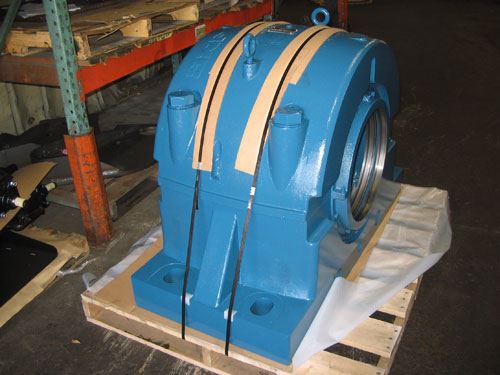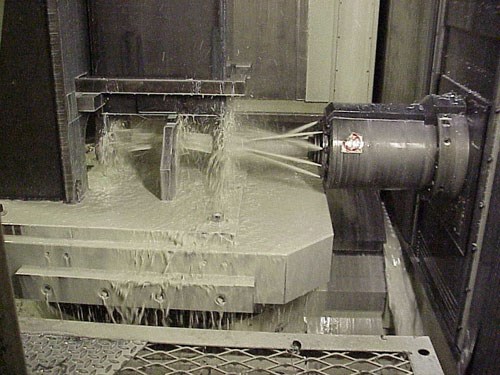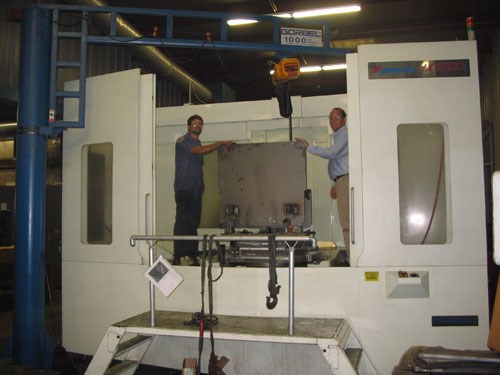HMC Reduces Cycle Time On Large Parts
Despite using Kitamura machining centers with great effect, this shop didn’t have a big enough machine to accommodate its largest jobs without a time-consuming, labor-intensive process. That is, until Kitamura released the MyCenter HX1000i, an HMC large enough for the company’s biggest jobs that maintains the features it likes most about other machines from the same builder.
Share





Any manufacturer that runs its machining centers 24/7 for years at a time has to make the quality and durability of those units a high priority. But when jobs call for high torque at low rpms on one shift and precision of ±0.0005 at high speeds the next, finding a line of machining centers that can cover all of a shop’s needs becomes difficult.
That’s the challenge K-Fab, Inc., a shop in Berwick, Pennsylvania, faced when it sought to replace its old machining centers to take advantage of new advances in technology. After a thorough review and comparison of units from several top manufacturers, the company chose Kitamura Machinery’s HX series of HMCs. The company’s latest purchase, the new HX1000i, has enabled it to take on larger, more complex jobs while maintaining the more than 99-percent quality rating it has worked so hard to achieve.
K-Fab is a general machine and fabricating shop that serves a variety of industries, including off-road construction, civil construction, auto-motive, industrial products and fire control. As a sole-source manufacturer, the company machines, assembles, paints and tests parts for its customers. The shop performs a wide variety of work, ranging from high-speed production involving chrome, iron and other heavy-duty materials to high-precision jobs that require tight
tolerances.
Founded in 1968 by Martin Koch, the company has grown from a three-man shop to one that employs more than 350 people. Much of that growth occurred during the past 12 years, thanks to a decision to move from strictly machining
and fabricating into becoming a sole-source manufacturer. The company is still family-owned, with Martin Koch remaining as president and his son Duane serving as second-in-command.
While Kitamura’s HX series machines worked well for much of the shop’s work, the HMCs simply weren’t big enough for jobs involving big parts used in construction and earth-moving equipment. The company had implemented a workable solution for such components—using an HMC to machine two sides before turning the piece to finish the two remaining sides—but that solution was less than ideal. Reorienting the workpiece after machining the first two sides proved to be a time-consuming and labor-intensive process. "It would take us an hour and a half to finish a single piece," says Randy Barnes, manufacturing engineer at K-Fab. "In a shop that is running at full capacity 24 hours a day, 7 days a week, that’s an eternity."
The shop searched for alternatives to this method, but none seemed worth the investment—particularly because the shop was using its Kitamura machining centers with great success on other jobs. Still, management kept its eyes open for an HMC large enough to accommodate the oversized parts while providing the quality, durability and power to which the shop had grown accustomed.
In early 2008, JBM Technologies, an East Coast distributor, notified the shop that Kitamura had developed a new HMC that appeared to be tailor-made for K-Fab. The Mycenter HX1000i offers a 39.37- by 39.37-inch work table and accommodates workpieces as large as 80.71 by 61.02 inches—more than enough capacity for the shop’s large construction industry parts. The machine also offers X-, Y- and Z-axis travels of 80.31 by 51.9 by 53.94 inches as well as a fourth (B) axis with travel of 0 to 360 degrees in 1-degree increments.
"As soon as I heard it was coming out, I said, ‘we need one of those,’" Mr. Barnes says. "We purchased one of the first of these machines that Kitamura built without seeing a sample because we were so confident that it could do what we needed it to do."
Of course, size was not the only determining factor—the shop had already passed on several machines from other builders that could accommodate its large workpieces. Mr. Barnes highlights the machine’s solid boxway construction, which he says provides more rigidity than linear machines. "It’s a little more expensive, but it makes a huge difference when it comes to precision and stability," he notes.
Additionally, the machine’s gear-driven spindles allow running at high torque and low spindle speeds for tough jobs. And, the machine is heavy—it weighs more than 126,000 pounds. Mr. Barnes says the extra mass makes the machine more solid, stable and rigid, allowing it to hold better tolerances on difficult materials or at high speeds. It is also less affected by temperature changes.
Mr. Barnes says another standout feature of the HX1000i is its 897 foot-pounds of spindle torque. That’s more than three times the torque of the shop’s Kitamura HX630i machines. On one job, K-Fab uses the machine to bore a 3-inch hole via helical interpolation at a feed rate of 116 ipm in high-production mode, yet the shop is "not even close" to pulling full loads on the spindle, Mr. Barnes says. "This capability is going to allow us to take on jobs we’ve never been able to do before, and we’ve been running the work we have on it so hard that we haven’t even had a chance to find out what else it can do."
Another feature Mr. Barnes highlights is the correlation between the machine’s rapid feed and cutting feed rates. He says that while most machines list a high rapid feed rate and much lower cutting feed rate, both figures are more than 1,400 ipm on the HX1000i. This allows the shop to take full advantage of the machine’s capabilities. "The machine’s true speed is determined by how quickly it can cut, no matter what other specs are put out there," Mr. Barnes says. "We really feel like we’ve gotten what we paid for."
Installing the machine and training the operators took only a few days, and its impact on the shop’s manufacturing process was immediate. Mr. Barnes says it has reduced production time by an hour per part in some cases, allowing K-Fab to shorten its production schedule and keep up with demand. The company has since moved other work onto the machine with similar results.
The most visible impact of the HX1000i has been increased production rates on large, high-durability parts, especially those manufactured from difficult-to-cut materials such as A572 grade 60, 80 and 100 structural steel. The shop has decreased cycle times by as much as 75 percent on such workpieces—a fourfold increase in productivity—while maintaining or even improving part quality.
Of course, the success of the HX1000i is only a part of the overall picture for K-Fab and its use of Kitamura machining centers. Less than 1 percent of the parts produced on the shop’s Kitamura machines are rejected, allowing it to maintain a reputation as a quality supplier while avoiding tying up machines on re-runs. All the units run 24 hours a day, 7 days a week. "There’s no way we could keep up this pace if we had to deal with the unplanned downtime you get with a lot of the machines out there," Mr. Barnes says. "We keep up with the recommended maintenance schedule, and the machines keep running. You can’t ask for more than that."
Related Content
Quick-Change Tool Heads Reduce Setup on Swiss-Type Turning Centers
This new quick-change tooling system enables shops to get more production from their Swiss turning centers through reduced tool setup time and matches the performance of a solid tool.
Read MoreOrthopedic Event Discusses Manufacturing Strategies
At the seminar, representatives from multiple companies discussed strategies for making orthopedic devices accurately and efficiently.
Read MoreInside the Premium Machine Shop Making Fasteners
AMPG can’t help but take risks — its management doesn’t know how to run machines. But these risks have enabled it to become a runaway success in its market.
Read More6 Machine Shop Essentials to Stay Competitive
If you want to streamline production and be competitive in the industry, you will need far more than a standard three-axis CNC mill or two-axis CNC lathe and a few measuring tools.
Read MoreRead Next
Setting Up the Building Blocks for a Digital Factory
Woodward Inc. spent over a year developing an API to connect machines to its digital factory. Caron Engineering’s MiConnect has cut most of this process while also granting the shop greater access to machine information.
Read More5 Rules of Thumb for Buying CNC Machine Tools
Use these tips to carefully plan your machine tool purchases and to avoid regretting your decision later.
Read MoreBuilding Out a Foundation for Student Machinists
Autodesk and Haas have teamed up to produce an introductory course for students that covers the basics of CAD, CAM and CNC while providing them with a portfolio part.
Read More




























.jpg;maxWidth=300;quality=90)











